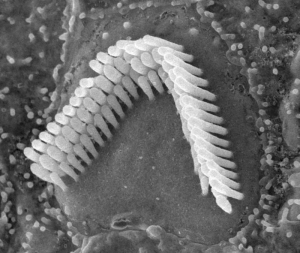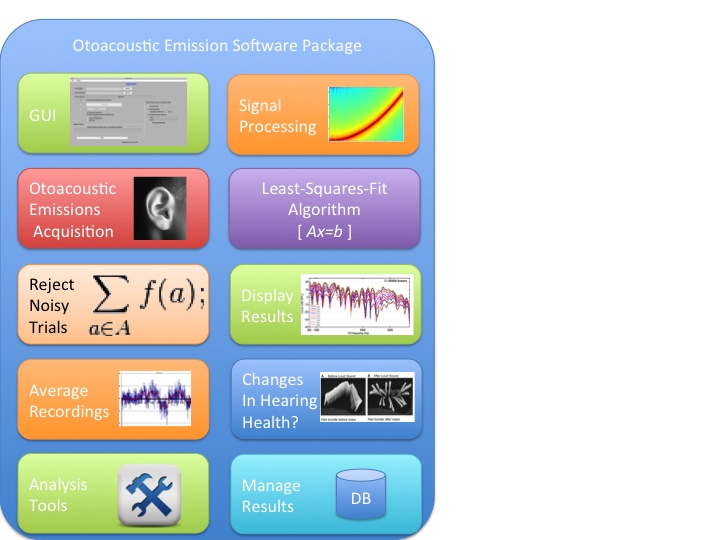Software Tools for Otoacoustic Emission Measurement
Joshua Hajicek, Speech-Language-Hearing Sciences
Faculty Advisor: Dr. Glenis Long
NML Awards: The History and Public Health Award (March 2014), The New Media Lab Digital Dissertation Award (April 2014)
Project Background
Hearing loss may occur naturally as we age (presbycusis), from taking ototoxic drugs (i.e. cisplatin, neomycin, high doses of aspirin, loop diuretics, and etc.), or from overexposure to noise or sound. According to the National Institute of Health (2008), 26 million Americans suffer from permanent and irreversible noise-induced hearing loss related to their workplace or recreational activities. Moreover, hearing related injuries are the most common service related injuries in the U.S. The effect of hearing loss is devastating and debilitating yet there are few tools to monitor subclinical changes in hearing health. Though helpful, hearing aids and cochlear implants only partially restore hearing so the only option is to identify changes in hearing health before they become permanent.
Project Description

One way hearing health may be monitored is by measuring an individual’s Otoacoustic Emissions (OAE). The purpose of the proposed project is to make advancements in OAE measurement available via an open source software application called OAEToolBox. We have also strived to make this software user friendly and MacOS/OS X and Windows compatible. We hope this application will augment research for hearing conservation basic hearing research.
OAEs are sounds emitted from healthy ears while listening to sound. OAEs originate within the cochlea (inner ear) and largely reflect the health and status of outer hair cell somatic motility; the process responsible for allowing us to perceive low intensity sounds as well as ensure that high intensity sounds remain comfortable. This process, often referred to as the “cochlear amplification” or “active process”, is the result of thousands of tiny outer hair cells (see image of a single outer hair cell) working in concert to amplify the displacement of the cochlear partition which spans the length of the cochlea. Each section of the partition is tuned so that it respond maximally to different frequencies. See http://www.youtube.com/watch?v=PeTriGTENoc for an introduction on how the ear works.
During the cochlea’s amplification process some of the energy outer hair cells generate is reflected/scattered back out of the ear where it can be measured with a small microphone placed in the ear canal. Over exposure to sound or ototoxic drugs temporarily or permanently damage or immobilize outer hair cells. Damage or immobilization therefore affects the amplitude and phase of OAEs. If OAE measurements are sensitive enough, small changes in hearing health may be detected. Absent or low amplitude OAEs are a good indicator of noise induced hearing loss. OAEs can also be used longitudinally to identify small changes in hearing health, before damage becomes clinical. Current barriers limiting present OAE measurement paradigms from being incorporated into hearing conservation programs include lengthy test times, high measurement variability within individuals, and lack of software to track OAEs longitudinally. For this project we designed and implemented a software platform that can be used to make rapid, sensitive, and efficient OAE measurements using swept tones and least squares fit analysis along with other clinic friendly measurement and analysis tools. The stable and validated (DPOAE) version of OAEToolBox is now open source and freely available for download and use at https://gitlab.com/simonhenin/oaetoolbox/. Note, that in order to download the software, you must first create a free gitlab account, login to the website, then download OAEToolBox. The software was written in and runs on the MATLAB platform.
As of September 28, 2018 the OAEToolBox contains the following modules. Additional modules for forward pressure level calibration (FPL), and continuous wavelet transform analysis are in currently in development.
Currently Available Modules (Name and Current Version Number)
- Discrete frequency Distortion Product OAE (DPOAE) measurement, 1.0
- Swept tone DPOAE, 1.0
- Medialolivocochlear efferent reflex (MOCR) tests for frequency swept SFOAE and DPOAE, 1.0
- DPOAE measurement based on Neely et al. (2009), 1.0
- Least Squares Fitting OAE analysis, 1.0
- Playrec (playrec v.2.1.1) simultaneous playback and recording as well as synchronous averaging, 1.0
- PsychPortAudio for real time and pseudo realtime simultaneous playback and recording as well as synchronous averaging, 1.0
- OAE Probe Microphone Calibration routines, 1.0
- Swept tone Stimulus frequency OAE (SFOAE) suppression measurement, 1.0
- Signal Generator, 1.0
- Temporal Averaging, 1.0
- Spontaneous OAE (SOAE) measurement 1.0
- Stimulus Calibration, 1.0
- System Calibration, 2.0
- Double evoked Transient Evoked OAE (TEOAE), 1.0
- TEOAE fast Fourier transform based analysis, 1.0
- Visual inspection artifact rejection, 1.0
- Weighted average artifact rejection, 1.0
- Real time analysis and monitoring
- Spectrogram Analysis
- Test Sequence Generation
- A basic database framework for storing all measurements and analyses.
